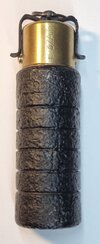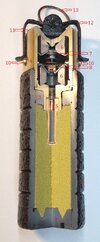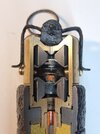pzgr40
Well-Known Member
Cutaway model of a Belgian 1930’s 1 Kg Sega aircraft fragmentation bomb.
The bomb has a steel body (1) with four V-shaped grooves to improve fragmentation. In the bottom a steel base plate (2) is screwed with a V-shaped groove machined in, also to improve fragmentation. In top of the bomb body a ring (3) is screwed to lock up the explosive charge. The fuze is screwed into the top of the bomb body.
The fuze is of the all-ways type. The fuze body (4) and the detonator housing (5) are brass made. Inside the fuze body two chamfered inertia rings (6) are placed. Two chamfered sheet metal plates are placed opposite one another on the inside of the chamfered inertia rings. The upper chamfered plate (7) houses the firing pin, the opposite chamfered plate (8) houses the firing cap. Between these two plates a weak spring is placed, keeping the two plates apart. With the fuze in safe position the plates are kept apart by two brass pins (10), both connected to a leaf spring (11) which is tensioned over top of the fuze body. A yoke shaped clamp (12) is placed over the leaf spring, forcing the two brass pins in the fuze body and between the two chamfered plates (7 & 8). The yoke shaped clamp is fixated by a split pin (13).
Before the bomb is dropped the split pin (13) is removed and one keeps the bomb in the hand with the fingers over the yoke shaped plate (12). When the bomb is dropped the yoke shaped plate falls away and the leaf spring (11) with the bras spins (10) expands, thereby pulling the two bras spins away from the fuze body, arming the fuze. If the bomb lands on the nose or bottom, the chamfered inertia rings will push the firing pin in the firing cap, or visa versa. The flame of the firing cap will ignite the detonator, which will ignite the main charge in the bomb body
If the bomb falls on it’s side, the chamfered inertia rings will move towards the ground, climbing the chamfered sides inside the fuze body, pushing both discs with the firing pin and the firing cap towards into one another, igniting the firing cap.
Complete bomb length : 160 mm
Length bomb body : 115 mm
Diameter bomb body : 50 mm
Wall thickness bomb body : 6 mm
Fuze diameter : 40 mm
Bomb weight : 1 Kg
Regards, DJH
The bomb has a steel body (1) with four V-shaped grooves to improve fragmentation. In the bottom a steel base plate (2) is screwed with a V-shaped groove machined in, also to improve fragmentation. In top of the bomb body a ring (3) is screwed to lock up the explosive charge. The fuze is screwed into the top of the bomb body.
The fuze is of the all-ways type. The fuze body (4) and the detonator housing (5) are brass made. Inside the fuze body two chamfered inertia rings (6) are placed. Two chamfered sheet metal plates are placed opposite one another on the inside of the chamfered inertia rings. The upper chamfered plate (7) houses the firing pin, the opposite chamfered plate (8) houses the firing cap. Between these two plates a weak spring is placed, keeping the two plates apart. With the fuze in safe position the plates are kept apart by two brass pins (10), both connected to a leaf spring (11) which is tensioned over top of the fuze body. A yoke shaped clamp (12) is placed over the leaf spring, forcing the two brass pins in the fuze body and between the two chamfered plates (7 & 8). The yoke shaped clamp is fixated by a split pin (13).
Before the bomb is dropped the split pin (13) is removed and one keeps the bomb in the hand with the fingers over the yoke shaped plate (12). When the bomb is dropped the yoke shaped plate falls away and the leaf spring (11) with the bras spins (10) expands, thereby pulling the two bras spins away from the fuze body, arming the fuze. If the bomb lands on the nose or bottom, the chamfered inertia rings will push the firing pin in the firing cap, or visa versa. The flame of the firing cap will ignite the detonator, which will ignite the main charge in the bomb body
If the bomb falls on it’s side, the chamfered inertia rings will move towards the ground, climbing the chamfered sides inside the fuze body, pushing both discs with the firing pin and the firing cap towards into one another, igniting the firing cap.
Complete bomb length : 160 mm
Length bomb body : 115 mm
Diameter bomb body : 50 mm
Wall thickness bomb body : 6 mm
Fuze diameter : 40 mm
Bomb weight : 1 Kg
Regards, DJH



